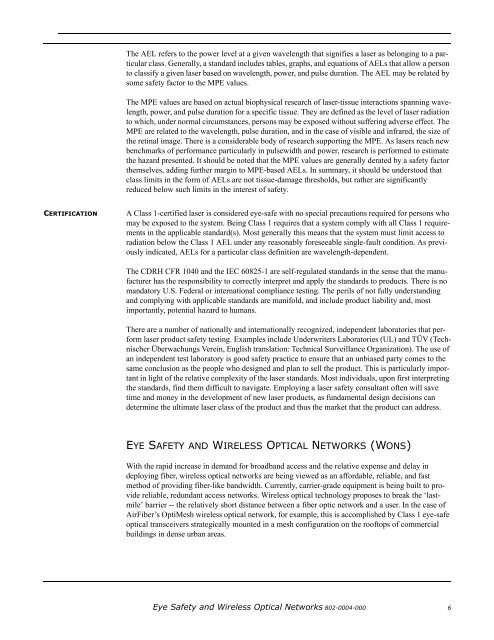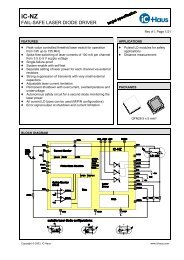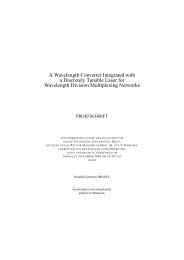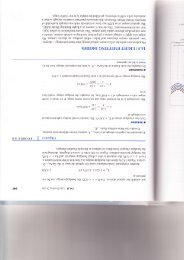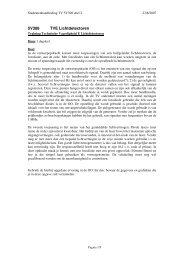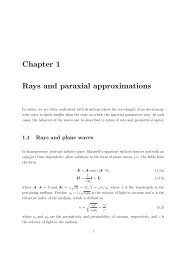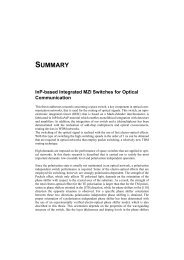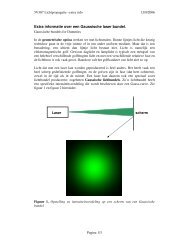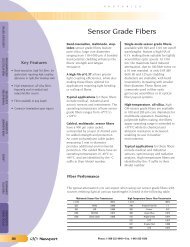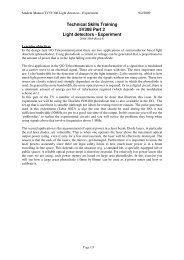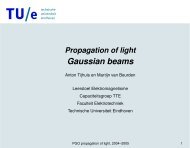Eye Safety and Wireless Optical Networks (WONs) - OED
Eye Safety and Wireless Optical Networks (WONs) - OED
Eye Safety and Wireless Optical Networks (WONs) - OED
You also want an ePaper? Increase the reach of your titles
YUMPU automatically turns print PDFs into web optimized ePapers that Google loves.
The AEL refers to the power level at a given wavelength that signifies a laser as belonging to a particular<br />
class. Generally, a st<strong>and</strong>ard includes tables, graphs, <strong>and</strong> equations of AELs that allow a person<br />
to classify a given laser based on wavelength, power, <strong>and</strong> pulse duration. The AEL may be related by<br />
some safety factor to the MPE values.<br />
The MPE values are based on actual biophysical research of laser-tissue interactions spanning wavelength,<br />
power, <strong>and</strong> pulse duration for a specific tissue. They are defined as the level of laser radiation<br />
to which, under normal circumstances, persons may be exposed without suffering adverse effect. The<br />
MPE are related to the wavelength, pulse duration, <strong>and</strong> in the case of visible <strong>and</strong> infrared, the size of<br />
the retinal image. There is a considerable body of research supporting the MPE. As lasers reach new<br />
benchmarks of performance particularly in pulsewidth <strong>and</strong> power, research is performed to estimate<br />
the hazard presented. It should be noted that the MPE values are generally derated by a safety factor<br />
themselves, adding further margin to MPE-based AELs. In summary, it should be understood that<br />
class limits in the form of AELs are not tissue-damage thresholds, but rather are significantly<br />
reduced below such limits in the interest of safety.<br />
CERTIFICATION A Class 1-certified laser is considered eye-safe with no special precautions required for persons who<br />
may be exposed to the system. Being Class 1 requires that a system comply with all Class 1 requirements<br />
in the applicable st<strong>and</strong>ard(s). Most generally this means that the system must limit access to<br />
radiation below the Class 1 AEL under any reasonably foreseeable single-fault condition. As previously<br />
indicated, AELs for a particular class definition are wavelength-dependent.<br />
The CDRH CFR 1040 <strong>and</strong> the IEC 60825-1 are self-regulated st<strong>and</strong>ards in the sense that the manufacturer<br />
has the responsibility to correctly interpret <strong>and</strong> apply the st<strong>and</strong>ards to products. There is no<br />
m<strong>and</strong>atory U.S. Federal or international compliance testing. The perils of not fully underst<strong>and</strong>ing<br />
<strong>and</strong> complying with applicable st<strong>and</strong>ards are manifold, <strong>and</strong> include product liability <strong>and</strong>, most<br />
importantly, potential hazard to humans.<br />
There are a number of nationally <strong>and</strong> internationally recognized, independent laboratories that perform<br />
laser product safety testing. Examples include Underwriters Laboratories (UL) <strong>and</strong> TÜV (Technischer<br />
Überwachungs Verein, English translation: Technical Surveillance Organization). The use of<br />
an independent test laboratory is good safety practice to ensure that an unbiased party comes to the<br />
same conclusion as the people who designed <strong>and</strong> plan to sell the product. This is particularly important<br />
in light of the relative complexity of the laser st<strong>and</strong>ards. Most individuals, upon first interpreting<br />
the st<strong>and</strong>ards, find them difficult to navigate. Employing a laser safety consultant often will save<br />
time <strong>and</strong> money in the development of new laser products, as fundamental design decisions can<br />
determine the ultimate laser class of the product <strong>and</strong> thus the market that the product can address.<br />
EYE SAFETY AND WIRELESS OPTICAL NETWORKS (WONS)<br />
With the rapid increase in dem<strong>and</strong> for broadb<strong>and</strong> access <strong>and</strong> the relative expense <strong>and</strong> delay in<br />
deploying fiber, wireless optical networks are being viewed as an affordable, reliable, <strong>and</strong> fast<br />
method of providing fiber-like b<strong>and</strong>width. Currently, carrier-grade equipment is being built to provide<br />
reliable, redundant access networks. <strong>Wireless</strong> optical technology proposes to break the ‘lastmile’<br />
barrier -- the relatively short distance between a fiber optic network <strong>and</strong> a user. In the case of<br />
AirFiber’s OptiMesh wireless optical network, for example, this is accomplished by Class 1 eye-safe<br />
optical transceivers strategically mounted in a mesh configuration on the rooftops of commercial<br />
buildings in dense urban areas.<br />
<strong>Eye</strong> <strong>Safety</strong> <strong>and</strong> <strong>Wireless</strong> <strong>Optical</strong> <strong>Networks</strong> 802-0004-000 6


